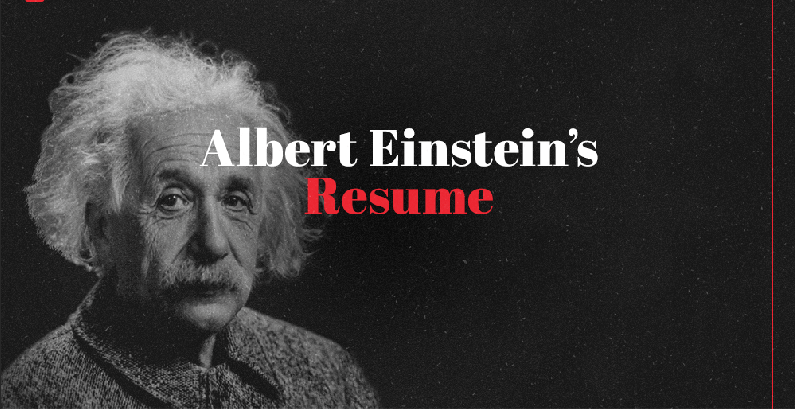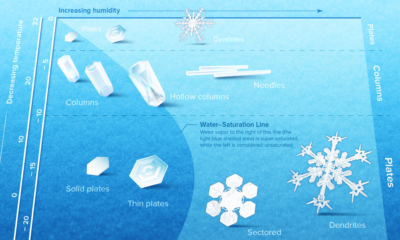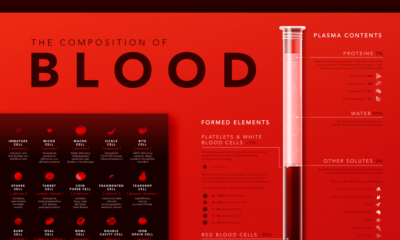Today’s timeline from KickResume is an inventive and entertaining look at Einstein’s life and achievements.
Younger Life
Albert Einstein was born on March 14, 1879, in the German city of Ulm. From an early age, Einstein was fascinated by mathematics, science, and music. While he would eventually go on to reveal the inner workings of the universe, Einstein struggled as a student, failed exams, and had dust-ups with authority figures. In 1903, he married a former classmate, Mileva Marić, though his parents disapproved. Recently discovered letters indicate that Marić – who was also a physicist – may have contributed significantly to his groundbreaking work. The couple had a daughter in 1902 (who was given up for adoption), and later had two sons.
Annus Mirabilis
In 1905, Albert Einstein was working as a clerk in the patent office in Bern, Switzerland. The 26-year-old had only recently submitted his doctoral thesis to the University of Zurich, but was hard at work writing four papers in a single year that would eventually turn the world of science on its head. That is why 1905 is often referred to as an annus mirabilis (or “miraculous year” in Latin). To summarize: Albert Einstein laid the foundation of quantum physics, introduced special relativity, and established the scientific basis of nuclear energy in his spare time.
From Science Star to Supernova
By 1919, while working as a professor of theoretical physics at the University of Berlin, Einstein theorized that an impending solar eclipse would provide a rare opportunity to observe gravity’s effect on light. When reports came back that his predictions were proven correct, it not only sent a shock-wave through the scientific community, but the whole world. – Headline in the London Times Years after Einstein’s miracle year, his immense accomplishments started to become common knowledge. The physicist, now an overnight celebrity, spent the next few years traveling, doing speaking engagements, and collecting awards. He was also a founder of the Hebrew University in Jerusalem in 1921, and won a Nobel Prize that same year. Albert Einstein was an outspoken pacifist and Jew, so as Hitler rose to power in Germany, he made the decision to emigrate to the United States. He accepting a position at the Institute for Advanced Study in Princeton, New Jersey. The physicist would never set foot in the country of his birth again.
Einstein and the Atomic Era
A month before World War II, Einstein and his colleague, Leo Szilárd, wrote numerous letters to President Franklin D. Roosevelt sounding the alarm that Germany was developing “extremely powerful bombs of a new type”. The President took the letters seriously and soon after, the Advisory Committee on Uranium (a precursor to the Manhattan Project) was created. Einstein carried the guilt of his role in sparking the development of atomic weapons, and he would continue to speak out against their use throughout the 1940s and onward.
The Fight For Equality
Seeing the parallels between the treatment of Jews in Germany and African Americans in his adopted country, Einstein became a member of the National Association for the Advancement of Colored People (NAACP). He campaigned for civil rights and in a famous speech at Lincoln University, he labeled racism “a disease of white people,” and added, “I do not intend to be quiet about it.”
Later Life
In 1952, Einstein declined an offer from Israel’s premier, David Ben-Gurion, to become president of Israel. At the age of 76, Einstein suffered an abdominal aortic aneurysm, but opted against surgery upon arriving at the hospital. “I want to go when I want,” he stated at the time. “It is tasteless to prolong life artificially. I have done my share, it is time to go. I will do it elegantly.” Albert Einstein died in his sleep on April 18, 1955. Though the man himself is gone, the legacy and unique world-view of the eccentric physicist continues to influence and inspire humanity to this day.
on Even while political regimes across these countries have changed over time, they’ve largely followed a few different types of governance. Today, every country can ultimately be classified into just nine broad forms of government systems. This map by Truman Du uses information from Wikipedia to map the government systems that rule the world today.
Countries By Type of Government
It’s important to note that this map charts government systems according to each country’s legal framework. Many countries have constitutions stating their de jure or legally recognized system of government, but their de facto or realized form of governance may be quite different. Here is a list of the stated government system of UN member states and observers as of January 2023: Let’s take a closer look at some of these systems.
Monarchies
Brought back into the spotlight after the death of Queen Elizabeth II of England in September 2022, this form of government has a single ruler. They carry titles from king and queen to sultan or emperor, and their government systems can be further divided into three modern types: constitutional, semi-constitutional, and absolute. A constitutional monarchy sees the monarch act as head of state within the parameters of a constitution, giving them little to no real power. For example, King Charles III is the head of 15 Commonwealth nations including Canada and Australia. However, each has their own head of government. On the other hand, a semi-constitutional monarchy lets the monarch or ruling royal family retain substantial political powers, as is the case in Jordan and Morocco. However, their monarchs still rule the country according to a democratic constitution and in concert with other institutions. Finally, an absolute monarchy is most like the monarchies of old, where the ruler has full power over governance, with modern examples including Saudi Arabia and Vatican City.
Republics
Unlike monarchies, the people hold the power in a republic government system, directly electing representatives to form government. Again, there are multiple types of modern republic governments: presidential, semi-presidential, and parliamentary. The presidential republic could be considered a direct progression from monarchies. This system has a strong and independent chief executive with extensive powers when it comes to domestic affairs and foreign policy. An example of this is the United States, where the President is both the head of state and the head of government. In a semi-presidential republic, the president is the head of state and has some executive powers that are independent of the legislature. However, the prime minister (or chancellor or equivalent title) is the head of government, responsible to the legislature along with the cabinet. Russia is a classic example of this type of government. The last type of republic system is parliamentary. In this system, the president is a figurehead, while the head of government holds real power and is validated by and accountable to the parliament. This type of system can be seen in Germany, Italy, and India and is akin to constitutional monarchies. It’s also important to point out that some parliamentary republic systems operate slightly differently. For example in South Africa, the president is both the head of state and government, but is elected directly by the legislature. This leaves them (and their ministries) potentially subject to parliamentary confidence.
One-Party State
Many of the systems above involve multiple political parties vying to rule and govern their respective countries. In a one-party state, also called a single-party state or single-party system, only one political party has the right to form government. All other political parties are either outlawed or only allowed limited participation in elections. In this system, a country’s head of state and head of government can be executive or ceremonial but political power is constitutionally linked to a single political movement. China is the most well-known example of this government system, with the General Secretary of the Communist Party of China ruling as the de facto leader since 1989.
Provisional
The final form of government is a provisional government formed as an interim or transitional government. In this system, an emergency governmental body is created to manage political transitions after the collapse of a government, or when a new state is formed. Often these evolve into fully constitutionalized systems, but sometimes they hold power for longer than expected. Some examples of countries that are considered provisional include Libya, Burkina Faso, and Chad.

















